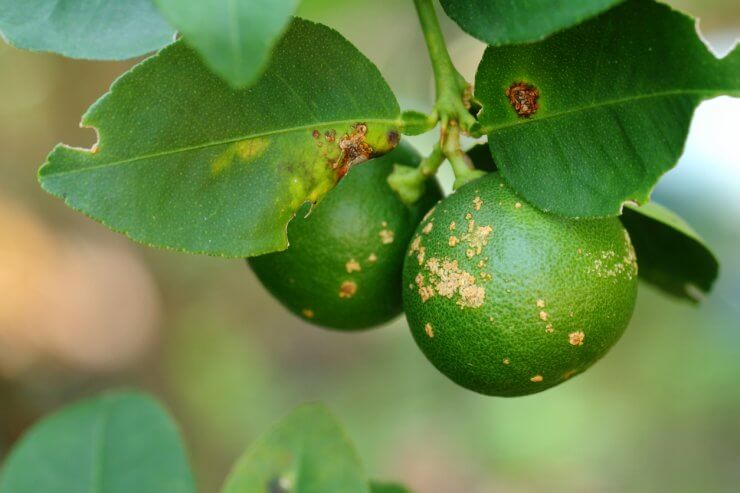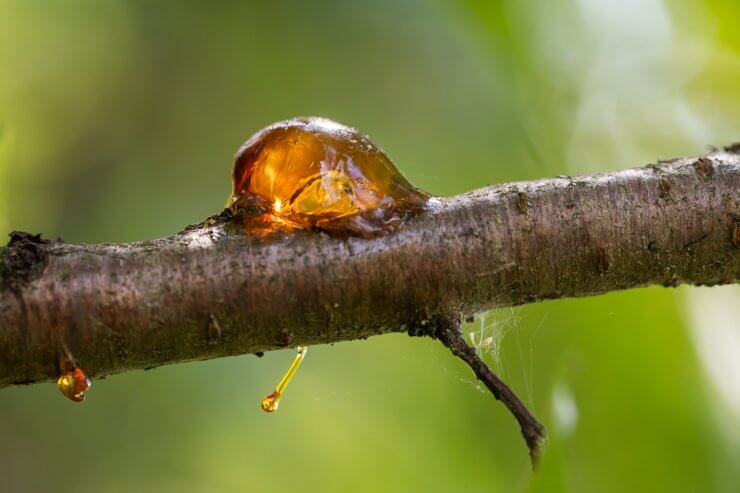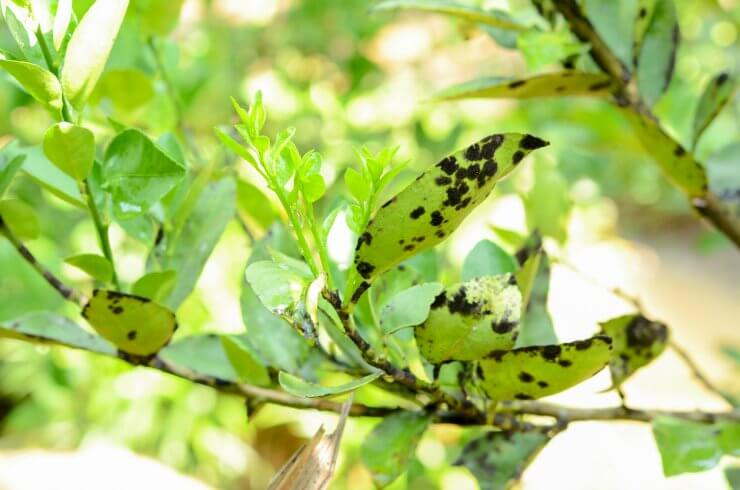
Fungal infection of lemon tree trunk
Like all food crops, lemon trees are susceptible to various fungal diseases. Your best weapons against these are best planting practices, which help prevent disease in the first place.
This is especially important, as there are no fungicides approved for home use for many diseases.
These best practices are aimed at producing strong, healthy trees that can withstand disease, and at avoiding situations that contribute to the development of disease. They involve keeping plants clean, dry, and undamaged.
Watering: Water your lemon trees deeply about once a week (check the soil for dryness). Do not over-water; lemon trees hate having wet feet! Soggy soil invites disease.
Mulch: Mulch can help with water retention—but be vigilant and check for insect or fungal activity.
Other best practices include:
- Buy healthy, disease-free plants from reputable sources
- Plant your tree in full sun
- Plant in sites with good drainage; if planting in open ground, choose a higher spot for better drainage and protection from cold air
- Proper winterization
- Harvest frequently and remove infected plants and fruit
Common lemon diseases
Here are some of the usual culprits that might infest your lemon tree. Remember, it’s important to remove diseased fruit, flowers, and leaves to prevent the spread of disease once it’s found its way onto your tree.
Algal Leaf Spot
Cause: Parasitic algae
Symptoms:
- gray, green, brown, or orange patches on leaf surfaces
- yellowing, dropping leaves
- reddish-brown patches wrapping twigs and branches
- branches appear stunted
How it Spreads:
- spores spread by rain, splashing water
- wind
Treatment:
- prune tree to improve air circulation and increase sunlight access
- liquid copper fungicide, if infection is severe
- remove and discard infected parts
Prevention:
- always water the soil around the tree; avoid wetting leaves
- ensure tree is getting adequate water, light, and fertilizer
- liquid copper fungicide
Anthracnose
Cause: Fungus
Symptoms:
- leaves turn yellow at the tips, eventually turning brown all around
- browned, dying leaves
- dark, sunken lesions on fruit and/or stems
How it Spreads:
- spores spread by rain, splashing water
- wind
Treatment:
- remove all infected parts
- clear ground of leaf and twig litter
- apply liquid copper fungicide to reduce recurrence
Prevention:
- prune tree to provide good air circulation and access to sunlight
- provide proper water and fertilizer
Citrus Brown Rot
Cause: Fungus
Symptoms:
- starts as a small spot and spreads
- leathery lesions with a strong smell
- worst on lowest-hanging fruits, especially those growing outdoors
How it Spreads:
- splashing water (rain, irrigation) disturbs spores
- wind
Treatment:
- destroy infected fruits
- prune low-hanging branches to provide more clearance
Prevention:
- spray with potassium phosphite or fosetyl-al in late July and again in October if fungus persists
- homemade fungicides
Citrus Black Spot
Cause: Fungus that overwinters in leaf debris; spores emerge in the spring
Symptoms:
- black spots on leaves or ripe fruit
- cracked or oozing black spots on fruit or leaves
How it Spreads:
- splashing water (rain, irrigation) disturbs and disperses spores
- wind
Treatment:
- destroy infected plant material immediately
Prevention:
- liquid copper fungicide
- plant disease-resistant varieties
- increase air flow through trees
- check trees daily
- keep harvested fruit as cold and dry as possible to slow development of lesions
Citrus Canker

Citrus Canker
Cause: Bacteria; highly contagious
Symptoms:
- yellow halo-shaped lesions on the fruit, leaves, and twigs
- leaf lesions progress from blisters to brown spots with water-soaked margins with a yellow halo
- center of lesion turns corky; visible on both sides of leaves
- defoliation (leaf drop), twig die-back, premature fruit drop
How it Spreads:
- air currents
- birds and insects
- humans—via infected garden tools and clothing
Treatment:
- destroy infected plants
Prevention:
- liquid copper fungicide
Citrus Greening (huanglongbing, or HLB)
This is a vascular disease that kills trees. There is no cure, but new treatment strategies are being developed and an infected tree may not be a total loss.
Cause: Bacteria carried by the Asian citrus psyllid
Symptoms:
- deformed new leaves
- mottled leaves
- corky leaf veins
- yellow shoots
- dying twigs
- lopsided, small, hard, bitter fruit
- tiny yellow eggs in new leaf growth
- thin, waxy tubes on new leaf growth
How it Spreads:
- Asian citrus psyllid (ACP)
Treatment:
- destroy severely infected plants
- trees may respond to proper irrigation, weed control, small frequent doses of fertilizer, increased foliar nutrition (micronutrients) at a 20% higher than normal rate
- Adjust soil pH to 5.8 to 6.5
- reduce Asian citrus psyllid population with a broad-spectrum foliar spray such as malathion
Prevention:
- purchase trees from reputable sources
- do not accept tree cuttings from uncertified sources
- preemptively spray with horticultural oil or insecticidal soap to keep ACP population down
Lemon Scab (Citrus Scab)
Cause: Fungal infection
Symptoms:
- pink or brown scabs on fruit and leaves
- scabs change to dark gray and crack as infection progresses
- leaves become wrinkled and puckered with ragged margins
- small growths on new shoots
- stunted, bushy growth
How it Spreads:
- spores spread by wind, dew, and splashing water (rain, irrigation)
- spores die when dry
Treatment:
- liquid copper fungicide can prevent new infections and spread of fungus, but cannot cure it
Prevention:
- choose disease-resistant cultivars
- plant with non-citrus trees (avocado, papaya)
- plant tree in area with good drainage
- prune tree to increase air circulation
- keep area under canopy clear of litter
Citrus Variegated Chlorosis (CVC)
Cause: Bacterial infection of vascular system
Symptoms:
- yellow areas on young leaves between the veins
- lesions on the underside of mature leaves
- symptoms can look like zinc deficiency
- symptoms may not appear for a year after initial infection
How it Spreads:
- sharpshooters, a species of leafhopper insects
- grafting
Treatment:
- prune affected limbs
- no current cure
Prevention:
- purchase trees from reputable sources
- use garlic spray to repel sharpshooters
- put aluminum foil over soil under tree to confuse insects
- encourage natural sharpshooter predators: lacewings, damsel bugs, lady beetles, and garden spiders
- use yellow sticky traps to catch insects
Greasy Spot
Cause: Fungal infection
Symptoms:
- yellow-brown blisters on leaves that darken on the upper surface and create raised lesions on the underside
- spots develop into oily looking blisters
- leaf loss
- spoiling fruit
- rust mites on trees could indicate infection
How it Spreads:
- fungus survives and propagates in dead wood and other crop debris
- spores spread by wind, dew, and splashing water (rain, irrigation)
- high temperature, high humidity, and leaf moisture creates ideal conditions for infection
Treatment:
- liquid copper fungicide
- collect and dispose of fallen/infected leaves to prevent the spread of new spores
Prevention:
- spray tree with liquid copper fungicide in late spring and late summer
- keep leaf litter to a minimum
- keep ground under tree free of debris
- do not use overhead irrigation
- do not plant in areas previously infected with greasy spot
- after harvest, apply lime and extra irrigation to speed up decomposition of leaf matter on the ground
- apply urea to slow fungal growth
Gummosis

Gummosis
Cause: Fungal infection (Phytophthora)
Symptoms:
- sap oozing from wounds or cankers on tree
- young leaves turn yellow or wilt
- leaves brown and drop
- sunken lesions on bark
- fungal chains grow out of the bark as curly orange threads
- whole branches may die
- if fungus grows around the trunk, the tree may collapse
How it Spreads:
- fungus survives over the winter in dead wood or in sunken lesions
- curly orange fungal chains release spores in the spring, spread by wind and water
- spores enter trees through wounds in the bark (insect damage, injury)
- warm, wet weather favors infection
Treatment:
- copper fungicide can be helpful at early stages of infection
- prune and dispose of diseased branches
- collect and dispose of fallen/infected leaves to prevent the spread of new spores
- if possible, burn infected wood
- removed darkened area of bark from tree, plus a border strip of healthy bark; keep area dry
- scrape diseased bark to find boundary of infection; burn lesion with a propane torch
Prevention:
- avoid damaging tree trunks with garden equipment
- do not allow soil buildup on root crown
- avoid planting in windy areas
- plant trees in well-drained soil
- plant trees on a mound to promote good drainage
- plant disease-resistant varieties
- disinfect gardening tools before using them on trees
Melanose
Cause: Fungal infection (more severe in trees older than 10 years)
Symptoms:
- scabbed fruit (does not affect fruit quality)
How it Spreads:
- fungus survives and propagates in dead wood
Treatment:
- prune affected limbs
- liquid copper fungicide
Prevention:
- liquid copper fungicide
Root Rot (Brown Rot, Collar Rot)
Cause: Fungal infection of the soil
Symptoms:
- dark patches of hardened bark on the tree trunk
- oozing spots on infected areas of the tree trunk
- dry, cracked bark
- dark canker on the bark
- yellowing, dying leaves
- brown, decaying fruit
How it Spreads:
- phytophthora fungus lives in soil; spreads after heavy rain or irrigation
Treatment:
- remove and destroy all infected leaves and damaged fruit
- prune lower branches for better clearance from the ground
- spray tree with fungicide (Agri-Fos, Captan)
Prevention:
- plant tree in an area with good drainage
- keep ground under tree clear of litter
Sooty Mold

Sooty Mold Disease on lemon tree
Cause: Fungal infection
Symptoms:
- blackened leaves
How it Spreads:
- mold forms on leaves after honeydew secretion of insects (aphids, mealybugs, whiteflies)
Treatment:
- liquid copper fungicide
Prevention:
- spray tree with neem oil, insecticide
Stem-End Rot
Cause: Fungus on the stems of the tree spreads to the fruit
Symptoms:
- discoloration at junction of stem and fruit
- looks like brown bruises
- discoloration on and in the fruit
- fruit rots in storage
How it Spreads:
- fungus is latent in tree until fruit is separated from stem (at the button)
- at initial infection, fruit is not affected
- fungus remains in dead wood
- heavy rainfall
- high humidity and temperatures
Treatment:
- harvest fruit by pulling it off the tree rather than clipping it
- destroy severely infected fruits and peels
- refrigeration stops the progression of the disease
Prevention:
- prune dead branches
- let fruit ripen on the tree longer
- spray trees with fungicide before harvest
- spray fruit with fungicide after harvest
Which diseases have you had to treat on your lemon trees? Please tell us how you prevent and handle diseases. If you spot other symptoms on your lemon trees that are not mentioned here, contact your local extension center or garden center for a consult—and please let us know what you discover.


 Previous
Previous

